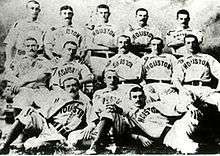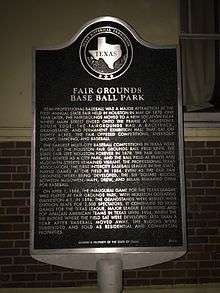Herald Park
| Full name | Herald Park |
|---|---|
| Former names | Houston Base Ball Park |
| Location |
2600 Travis Street Houston, Texas |
| Owner | Houston Electric Company[1] |
| Operator | Houston Baseball Association |
| Field size |
LF 310 CF 403 RF 310[2] |
| Construction | |
| Opened | 1884[3] |
| Renovated | 1896,[3][2] 1898,[4] 1903[1] |
| Closed | July 2, 1904 |
| Demolished | 1904 |
| Tenants | |
|
Houston Nationals (TL) (1884) Houston Heralds (1887) Louisville Colonels (MLB/spring training) (1895) St. Louis Cardinals (MLB/spring training) (1904) Houston Buffaloes (STL, TL) (1888–1904) | |
Herald Park (also known as Houston Base Ball Park, Fair Ground Park,[5] and League Park[3]) was a baseball park located in Houston, Texas and was the home of the Houston Buffaloes from 1888 until 1904. It also served as the spring training facility for the Louisville Colonels and the St. Louis Cardinals in the National League of Major League Baseball in 1895 and 1904 respectively.
The ballpark existed near the Houston fairgrounds at the intersection of Travis Street and McGowen Street on the eastern edge of Fourth Ward. Today, Houston's Reef restaurant sits on the location of Herald Park. In 2016, the Texas Historical Commission commemorated the ballpark by placing a historical marker on the location.
History
Planning and construction


On July 2, 1884, a meeting was held in the office J. W. Mitchell that decided to issue 120 shares of stock at $10 each for the purpose of preparing a baseball park.[6] Mitchell, along with W. H. Coyle and Colonel Will Childress headed a committee to sell such shares. Built in a largely unpopulated area of prairie land, on the grounds of the State Fair of Texas, fences and a grandstand were erected on the site by 1885.[3]
Regular use
The ballpark became the home of the semi-professional Houston Heralds club in 1887, and the site became known as "Herald Park".[7] The Heralds were named as such because their owner, William H. Bailey, also owned the local newspaper called the Houston Herald. Although the Heralds team ceased after that season, many continued to refer to the ballpark by this name well into the 20th century.
Two big-league ball clubs barnstormed through Houston in 1887, the New York Giants and the St. Louis Browns, and played at Herald Park. When the Browns played, they faced a team composed of five from the Chicago White Stockings, two from the Pittsburg Alleghenys, and two from Cincinnati Red Stockings.[8] The Red Stockings as a whole returned to Houston the following season, but this time as the opponent of Houston's first fully professional ball club in their first ever game.[9]
Herald Park was the site of the first modern Texas League game between Houston and Galveston on April 1, 1888. Houston won the game 4-1.
On April 28, 1889, a mysterious fire burned down the grandstand, the ladies stand, reporters' stand, and soda stand.[10] Rebuilt soon thereafter, none of the property was insured, and an estimated total cost of damage was $1,200 (equivalent to $31,658 in 2015).
The first night game was held at Herald Park on July 22, 1892 when Houston manager John McCloskey ordered arc lights to be placed on the field in a game against Galveston.[3][11]
The Louisville Colonels of the National League became the first big league ball club to come to Houston for spring training in 1895 as Herald Park was their home, while the Chicago White Stockings (now known as the Chicago Cubs) made their home in nearby Galveston.[12] The two teams played each other frequently with the use of the interurban.[13]
In 1898, the ballpark received renovations when the left field fence was moved one hundred feet and the diamond moved fifty feet out toward Main Street.[4] A plank for fans to walk from the streetcar landing to the gate was also added.
The ballpark served as the spring training facility for the St. Louis Cardinals, also of the National League, in 1904.[14] It was the beginning of a long history of that club with Houston, as they returned for spring training in 1906 through 1908 at West End Park, and then purchased an eighteen percent share of the Houston Buffaloes before making them the first minor league farm team in 1921.
Redevelopment, closure, and demolition
The ballpark's demise was foreshadowed by a 1903 meeting of the Fourth Ward Civic Club, where they advocated removal of the park.[15] Although owned by the Houston Electric Company throughout the majority of its existence, the ball park was sold to a real estate development company before the beginning of the 1904 season.[7] However, on April 5, 1904, it was announced that Houston would continue to use the ballpark at least until August because the developers were not yet ready to build on the site.[16] Throughout the season, development did eventually begin before August, and the size of the field was necessarily modified. Game rules became inventive to accommodate the shrunken size.[7]
Houston's professional baseball team played its last game at the park against the Beaumont Millionaires on July 1, 1904.[17] West End Park, the permanent successor to Herald Park, was constructed and opened in April 1905.
Notable events
Birth of the "Texas Leaguer"
Houston center fielder Ollie Pickering set a Texas League record for singles in the season opener game and Pickering's Texas League debut against the Fort Worth Panthers on May 21, 1892 at Herald Park.[18] According to the April 21, 1906 edition of Sporting Life, this game was the origin of the "Texas Leaguer" term used to describe a single that falls just outside the infield because Pickering's first seven at bats were consecutively successful in this manner.[19] This Texas League record still stands today.[20]
Other uses
American football
Herald Park also occasionally served as a venue for American football games. Galveston's Ball High School played a game against a team from Houston known as the "Olympics" on November 26, 1896.[21] The same Houston team would then play against TCU in that university's second ever game on December 19, 1896.[22] The next month, the Olympics played Houston High School.[23] Herald Park also served as a neutral football site on several occasions. Texas A&M was defeated by Sewanee there,[24] but would return for their next game against Tulane to be victorious.[25]
Transportation access
Herald Park was served by the Houston Electric Company's South End line, which provided street car access during its time.[26] With transfers from Houston's Grand Central Station, this allowed for direct public transportation using interurban lines such as the Galveston–Houston Electric Railway and Houston North Shore Railway.[27]
See also
- List of baseball parks in Houston, Texas
- West End Park (Houston)
- Buffalo Stadium
- Colt Stadium
- Astrodome
- Minute Maid Park
Sources
- "Baseball in the Lone Star State: Texas League's Greatest Hits", Tom Kayser and David King, Trinity University Press 2005
References
- 1 2 "Ground Money Appropriated". Houston Chronicle. March 18, 1903. p. 10.
- 1 2 "Texas Baseball Notes". Houston Post. January 5, 1896. p. 17. Retrieved August 28, 2013.
- 1 2 3 4 5 Johnston, Harry M. (July 10, 1904). "The Old Ball Park". Houston Post. p. 17.
- 1 2 "Local Baseball Matters". Houston Post. February 28, 1898. p. 3. Retrieved September 16, 2014.
- ↑ "Base Ball In Texas". Galveston Daily News. July 25, 1888. p. 2.
- ↑ "Base Ball". Galveston Daily News. July 4, 1884. p. 5.
- 1 2 3 "New Ball Park". Galveston Daily News. June 19, 1904. p. 4.
- ↑ Larry Dierker Chapter – Society for American Baseball Research (2014). Vance, Mike, ed. Houston Baseball, The Early Years: 1861–1961. Houston: Bright Sky Press. pp. 325–326. ISBN 9781939055743.
- ↑ "Were Not Shut Out". Houston Chronicle (2nd ed.). March 7, 1888. p. 5.
- ↑ "The Fire Fiend at Large". Galveston Daily News. April 29, 1889. p. 3.
- ↑ "Going to Houston Today". Galveston Daily News. July 22, 1892. p. 8.
- ↑ "Scattered Hits" (PDF). Sporting Life. 24 (23). 1895. p. 11.
- ↑ Larry Dierker Chapter – Society for American Baseball Research (2014). Vance, Mike, ed. Houston Baseball, The Early Years: 1861–1961. Houston: Bright Sky Press. pp. 319–320. ISBN 9781939055743.
- ↑ "Stubenrach to Resign". Galveston Daily News. February 7, 1904. p. 6.
- ↑ "Houston". Houston Post. January 24, 1903. p. 2. Retrieved March 5, 2014.
- ↑ "Houston Will Use Old Park". Galveston Daily News. April 6, 1904. p. 4.
- ↑ "The Game Today". Houston Post. July 1, 1904. p. 3.
- ↑ "In Hard Luck". Galveston Daily News. May 22, 1892.
- ↑ "Texas Leaguers." (PDF). Sporting Life. April 21, 1906. Retrieved July 7, 2014.
- ↑ "Texas League Individual Records". Texas League. Retrieved July 7, 2014.
- ↑ "Houston 6; Galveston 0". Austin Weekly Statesman. December 3, 1896. p. 10. Retrieved March 5, 2014.
- ↑ "Football at the Park". Houston Post. December 20, 1896. p. 6. Retrieved March 5, 2014.
- ↑ "Football Game Yesterday". Houston Post. January 23, 1897. p. 8. Retrieved March 5, 2014.
- ↑ "Foot Ball Game". Houston Post. November 10, 1899. p. 10.
- ↑ "Good Sport Looked For". Houston Post. November 27, 1899. p. 3. Retrieved March 5, 2014.
- ↑ "The Houston Electric Company". Houston Post. November 16, 1902. p. 48. Retrieved March 13, 2014.
- ↑ "Houston North Shore Railway". The Handbook of Texas. Texas State Historical Association. June 15, 2010. Retrieved March 11, 2014.
| Preceded by None |
Home of the Houston Buffaloes 1888 – 1904 |
Succeeded by Harrisburg Park |